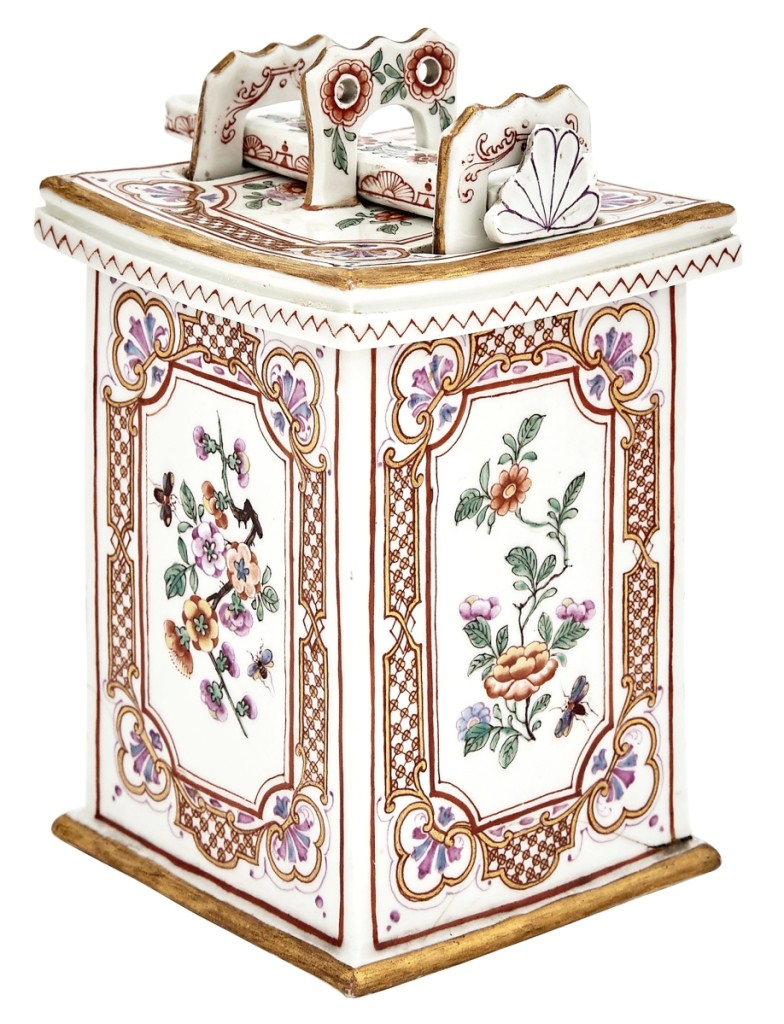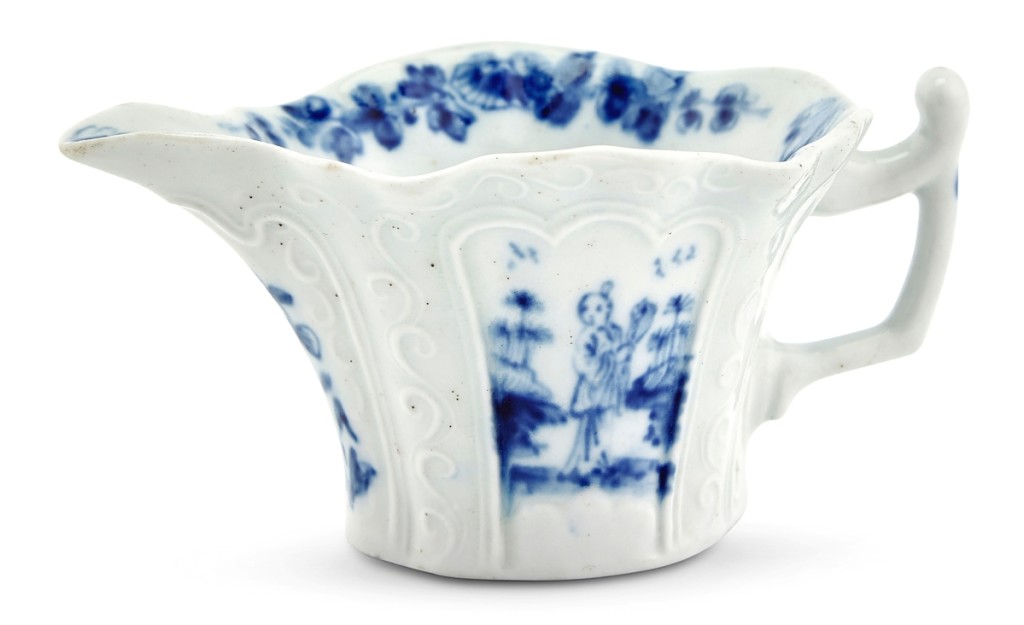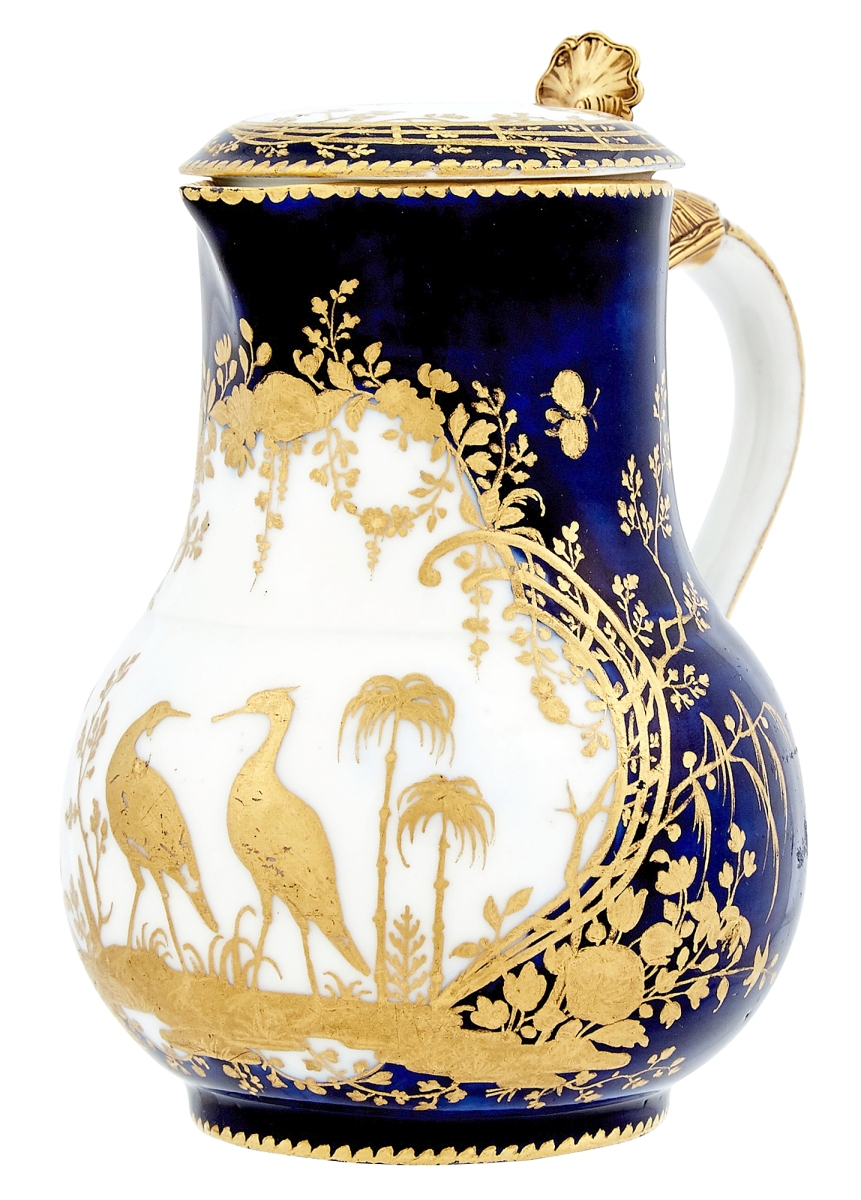
Leading the sale at $94,500 was this 6¼-inch-tall porcelain tobacco box, cover and tamper made in Vienna by du Paquier, circa 1730. A new client to Doyle, bidding from Asia, won the lot ($15/25,000).
Review by Madelia Hickman Ring
NEW YORK CITY – Collectors have vastly different acquisition strategies. Some amass with a broad net; others make a deep dive into a particularly narrow collecting category. It was the latter strategy that Belk department store heiress Sarah Belk Gambrell employed in her pursuit of examples of European porcelain. A resident of Charlotte, N.C., who died at the age of 102 in 2020, Gambrell was part of a circle of ceramics enthusiasts connected with the Mint Museum, which has a prominent collection of English and European ceramics. Many of the pieces Gambrell collected were so rare, perhaps even singular, that arranging them side by side offered a rare opportunity for study. With international competition, the sale achieved a total of $1,031,562, just cracking the $645,000/1,027,500 estimate. Doyle reported that 88 percent of the lots sold.
“I’m very pleased and gratified that we made the estimates,” Doyle’s specialist in charge of the sale, David Gallagher, said. “This was an important collection of very rare items, and the air is thin up there for the number of collectors. We got some nice prices, which is always good to see.” He said that interest was particularly strong from Europe, which beat out against many collectors and institutions from the United States.
The sale was organized by maker and largely chronological, an accommodation to those collectors of a particular pottery or manufactory. It is perhaps unsurprising that most of the top prices went for early pieces.
A porcelain tobacco box that was made by du Paquier in Vienna, circa 1730, was unusual because it retained its original cover and shell-form tamper that served as a crossbar horizontal lock. Decorated in a Japanese palette with alternating prunus and peony panels, the box related to an example at the Österreichisches Museum in Vienna and another at the Metropolitan Museum in New York City. Gambrell had acquired it from Parke-Bernet Galleries in September 1969 and it also had provenance to the Wetmore estate of Newport, R.I. Gallagher noted that a buyer in Asia, who had not previously bought from Doyle, acquired it for $94,500.
It was the top price in the sale.

Small piece, big price. Bringing $59,850 and the third highest price in the sale was this 1½-inch-tall Lund’s Bristol porcelain hexagonal blue and white cream boat that was marked “Bristol” underneath ($10/15,000).
The auction featured another half-dozen works by du Paquier, some of which had provenance to the Wetmore estate and were acquired by Gambrell at the same Parke-Bernet Galleries auction in 1969. These included a porcelain tankard and cover that was decorated in a chinoiserie taste; offered at $10/20,000, the 6-inch-tall baluster vessel topped off at $44,100. An impressive looking partial condiment set and stand was decorated with deutsche-Blumen peony and chrysanthemum bouquets and sprays, relating it to a teapot in the R. Thornton Wilson collection at the Metropolitan Museum of Art. According to the catalog essay, neither the central figure nor any other condiment sets are known to exist. It sold within estimate for $28,350.
“This collection as it was assembled was meant to be a teaching collection. I was able – by viewing things side by side – to see things that you wouldn’t be able to otherwise. It was a real pleasure for me,” Gallagher said.
Gallagher pointed out two lots that illustrated his point. Both were Kakiemon porcelain decagonal bowls, one was made in Japan in the late Edo period, circa 1700, the other, a European copy of the Japanese original made by Meissen around 1730. Both bowls had been owned by Baron Thomas Dimsdale (1712-1800) and descended in Dimsdale’s family before being sold at Sotheby’s London in 1970. Both lots were purchased by separate buyers from Asia, with the Meissen example offered first and selling for $69,300; the Japanese bowl realized $13,860.
One could find the history of European porcelain in Gambrell’s collection. A Lund’s Bristol porcelain blue and white cream boat that dated to 1749-1751, was marked “Bristol” in raised letters and was tiny – just 1½ inches tall – but it brought a big price of $59,850 and the third highest price of the day. The catalog essay for the lot denoted its rarity and importance, tying it to several known published examples as well as its provenance to a private Nova Scotia collection, a Sotheby’s London sale in 1973 and Winifred Williams, Ltd., of London, where Gambrell had acquired it. Gallagher said had it not been for the word “Bristol,” he might not have known where it was made and, for that reason, had documentary importance.

“That was interesting because it has gold mounts rather than silver gilt ones,” David Gallagher said. This circa 1751-53 Vincennes Porcelain bleu lapis jug and cover more than doubled the high estimate and sold to an American buyer for $34,650. Gallagher said it may be included in a forthcoming book on Madame Pompadour and Sevres Porcelain by Rosalind Savill ($10/15,000).
Gambrell’s collection was well documented, which porcelain collectors appreciated. Four pieces of Meissen porcelain from the “Christie-Miller” service were offered that realized, respectively, $34,650 for an ogival quatrefoil bowl, $23,940 for a second ogival quatrefoil bowl, and two small octagonal plates that made $10,710 and $20,160.
A Vincennes Porcelain bleu lapis jug and cover sold to an American buyer for $34,650 and may be included in a forthcoming book by Rosalind Savill. It was unusual because it featured gold mounts rather than silver-gilt ones, and while the catalog essay denotes related examples, it does not indicate where Gambrell acquired it.
Doyle will offer Gambrell’s Chinese works in its September sale of Asian works of art, and her furniture in its Fall English and Continental furniture sale.
Prices quoted include the buyer’s premium as reported by the auction house.
For more information, 212-427-2730 or www.doyle.com.




















